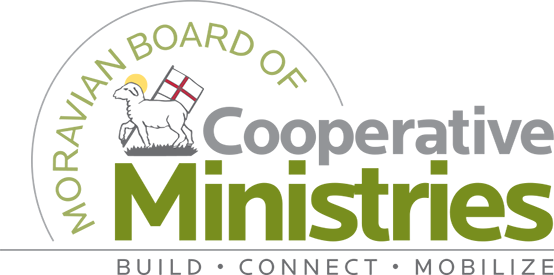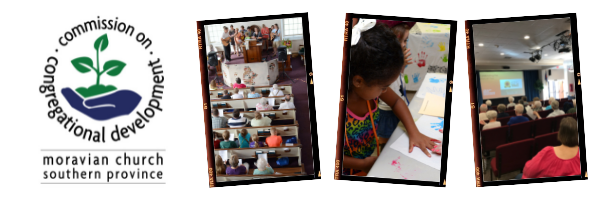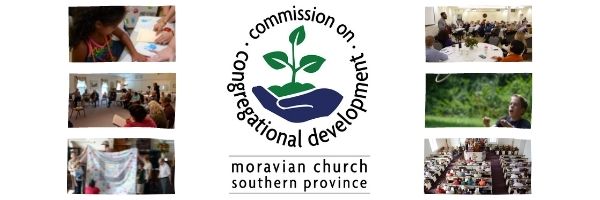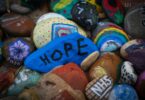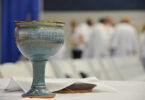
BY WILLIAM NEEDS |
Note: This is part of a monthly blog series, “Coffee with Moravian Ancestors.” Bill sits down with important figures in the Moravian church to have a cup of (Moravian) coffee, asking questions about his or her life and how they have impacted the church! Look for Bill’s other blog posts here. To accompany his blog posts, he has drawn the images from his trip to Europe on the Roots of the Moravian Church Tour. For more art, visit Bill’s website at BillNeeds.com.
__________________________
The “starboard brace” is a station on the deck of a square-rigged schooner where lines controlling the sails aloft converge to be fastened. Whipped by a winter storm during a 1735 voyage from London to the English Colony of Savannah, John Wesley witnessed a scene he would not forget.
With the wind howling and ship tossing around, every living soul aboard seemed threatened. But, huddled at the starboard brace Wesley saw a small band of men and women hanging onto the ropes and each other, singing praises in German to their Lord and offering thanks for good health and comfort in His presence. In all his religious training he had never seen such confident expressions of faith. These were carpenters and farmers, called Herrnhutters. They had kept to themselves while crossing the Atlantic. They knew nothing about sailing, but the sound and tempo of their songs seemed in harmony with the wind in the rigging and pounding on the waves. Moved by this expression of faith, Wesley wanted to learn more.
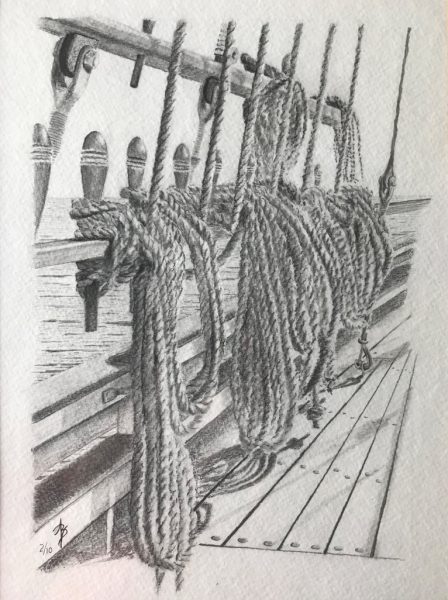
Artwork by Bill Needs
Coffee with John Wesley 1703-1791
Q. Reverend Wesley, tell me how it happened you were on the same ship carrying the Moravians to Savannah?
A. The first church to which I was assigned was the Anglican parish located in Savannah, in the English colony of Georgia. You see, when I graduated from Oxford University in 1728 I was ordained a priest in the Anglican Church but not immediately assigned a parish. So my brother and I used this opportunity to organize a Bible Study group in London. We called ourselves the “Holy Club.” We defined methods for worship, study, and service which seemed sensible to me, a way to reinforce responsible behavior based upon holiness, but drew ridicule from others.
Our club emerged at a time when the Protestant Reformation had lost its appeal. Protestant congregations were bored by sermons seemingly disconnected from daily living. An age of “reason” was also growing to challenge the status quo and religious minds reacted with a movement known as the “Great Awakening.” Revival meetings whipped up a fervor among common men and women in Britain and its North American colonies during the 1730s and ’40s. A renewed interest in and movement toward pietism also appealed to some discontented Protestants. Halle University in Germany had grown from a boarding school into a center for pietism as taught by theologian August Hermann Francke. Ludwig Nicolaus von Zinzendorf studied under Francke during his formative years (age 10-16) and as an adult was noticed for his revolutionary experiment offering practical pietism as a reasonable approach to religion.
At Oxford, I was taught that Zinzendorf had established a social laboratory, of sorts, where he experimented with his beliefs. He invited descendants of the ancient Unitas Fratrum to settle on his estates.
For centuries, members of this church had practiced pietism which was outlawed by the Catholic Church in Bohemia and Moravia. When Zinzendorf offered freedom to practice their pietistic worship on his estate, they established a commune called Herrnhut.
Herrnhut became a source of envy throughout Europe. The combined resourcefulness, industry, devotion, and discipline of these “Moravians” under Zinzendorf’s guidance seemed to be blessed by God. Community leaders who wanted to emulate Herrnhut’s success sent inquiries to Zinzendorf. Zinzendorf responded by sending Herrnhuters to establish Moravian-modeled societies “in diaspora” in their local churches.
For 8 years, Moravian diaspora societies spread across northern Europe. They were entering England about the time I began my service as an Anglican priest to the British colonists settling in Savannah.
In 1732 Zinzendorf also began sending Herrnhuters beyond Europe to spread the Christian message to the heathen in distant lands. Because the Moravian model of practical piety seemed to be fueling the Great Awakening in England, I was pleased to learn some of my shipmates bound for Savannah in 1735 would be Moravian families sent to supplement a mission to the Native Americans there.
Q. I understand you were impressed with the Moravian pietism prior to witnessing their real-life expression of faith onboard the ship in a storm. What did you do with that information?
A. Actually, I was not sure what to do with that information. It was a revelation. I had read about “pietism” and thought I understood it rationally. But to witness their devotion during that storm was no doubt a practice of pietism in its purest form; behavior far beyond any rational understanding; as though Jesus Christ stood among them, holding them up in their fear and joining them in their songs praising God. As a Priest representing the Church of England, I was unable to find German words to inquire about this unique Moravian faith.
Arriving in Savannah in 1736, I asked to meet their leader. August Spangenberg had lived in London for a few years negotiating with Oglethorpe to locate a Moravian mission in Savannah. He had arrived in Savannah only nine months earlier with the first wave of Moravian missionaries. With the arrival of my shipmates, he was preparing his departure for Pennsylvania to investigate other opportunities for Moravian missions and schools. Spangenberg was fluent in English so I felt fortunate to be granted some of his time, however briefly.
When I described the behavior I had seen of Moravian shipmates during the storm, he quickly saw through my profession of faith and gently asked a few pointed questions; “Does the Spirit of God bear witness with your own spirit, that you are a child of God?” Surprised by his directness, I stumbled over myself trying to compose a response. He followed without any hint of judgment, “Do you know Jesus Christ?” to which I replied, “I know that He is the Saviour of the world.” He paused looking deep into my eyes. Then he leaned slightly toward me to press one last thoughtful question home, “Do you know that He has saved you?” I stammered my reply “I hope He has died to save me.”
Our acquaintance was brief, but his words remained with me for the two years that I carried on with what I must admit was a rather ineffective and unfulfilling ministry. I became good friends with the Moravians who also struggled in their mission efforts only a short distance from my church. My failures in Georgia and encounters with the Moravians led me to question my own faith. As I recorded in my journal, “I, who went to America to convert others, I was never myself converted to God.”
Q. It sounds like your service in Savannah was a disappointment. Is that true?
A. My parish in Savannah was 200 miles long and populated by a class of Englishmen lower than that to which I was accustomed; mostly men granted freedom from English debtors prisons in London. There were also Portuguese Jews, a German colony of Salzburgers, and another colony of Scotch Highlanders. Serving as a priest for such a diverse congregation was far more than one seasoned man could handle, let alone one who lacked confidence in self and spirit.
My brother Charles had accompanied me to Savannah, but when he became entangled in some political quarrels, he retreated to London. Without his support, I resorted to frequent visits to the Moravian community where I found comfort in their simple huts and orderly plantations, sensitive conversation, and joyous worship filled with song.
In hindsight, I think my High Church notions and strict standards for living had little practical application to the collection of colonists struggling in the wilderness to eke out a living. By December of 1737, I left Georgia a defeated man. My replacement was a young priest-apprentice, George Whitefield, who was becoming a powerful “outdoor preacher” in England.
I previously knew George Whitefield as a member of our “Holy Club.” Trained also in theatrics, he used precise pronunciation and dramatic effects when preaching, earning a reputation in England for his fiery oratory. As the Great Awakening grew Whitefield would become its vanguard.
Q. Tell me more about what followed your return to Europe.
A. Returning to London in 1738, I made it a point to associate with Germans who were establishing Moravian societies around England. Peter Boehler was a Moravian leader assigned to establish a Diaspora society on London’s Fetter Lane. When I attended Moravian worship at the Fetter Lane Chapel, I heard an explanation of faith that I could fully accept. My heart felt strangely warmed.
I established a close friendship with Peter Boehler while he waited for a ship to Savannah. Brother Peter continued the conversation started with Bishop Spangenberg two years earlier. He counseled me to understand and accept that my heartwarming experience was indeed an evangelical conversion that would provide the blessed assurance I had been seeking.
Continuing to investigate the Moravian faith, I visited Zinzendorf in Herrnhaag Germany. Zinzendorf remained loyal to the Lutheran Church despite banishment from his home in Saxony due to his revolutionary ideology and involvement with Moravians. I also visited Moravian leaders in Herrnhut and was enamored with the simplicity of their service-orientated faith and their passion for spreading the message of Jesus through education and personal example.
We discussed matters of faith and even considered merging our Christian missions. Although we had much in common, it seemed revival methodology and salvation theology did not rest easily upon the humble and extremely pious Moravians. I remained active in the Fetter Lane Society until 1740 when we mutually agreed to separate as friends rather than attempt to force a merger of theological and methodical thought.
I also decided to leave the Anglican Church and, using the inspirational model of Moravians, established tenants for the Foundery Society out of which the Methodist Church would emerge.
Q. It seems that the Methodist Church evolved in England while the Moravian mission effort continued to evolve in America. Is that right?
A. Back in Savannah, my replacement did not last long. While serving the Anglican parish in Savannah, George Whitfield was distracted by the large number of orphaned children from indentured servants and debt-bound settlers who initially populated Oglethorpe’s Georgia. Stirred by the obvious need of Savannah’s street children, Whitefield remained only 3 months before returning to London to receive his ordination in the Anglican Church.
In England, Whitefield received his ordination but immediately set out conducting outdoor fund-raising events to raise funds for his Savannah orphanage. To call them successful is an understatement. His sermons drew thousands of men and women hungry for a heartfelt message that rattled the spirit-starved soul from straight-laced Liturgies and Sermons commonly found in Anglican Church worship.
Whitefield made an impact upon all Englishmen who heard him but his goal was not to serve as a preacher but to establish a ministry to Savannah’s orphans. He would not be deterred. In 1739 he turned his followers over to my care. It can be said that membership of the Methodist Church emerged out of Whitefield’s loyal followers while he prepared to return to America.
His 1739 return to America was skillfully publicized to offer a series of revival tours all along the East Coast, ending in Georgia. Like a modern-day “Rock Star,” he quickly became a celebrity among all hard-working and independent-thinking colonists.
Q. At this point, Whitefield’s ministry no longer represented the Anglican Church. His version of Methodism was represented in his creation of an orphanage, true?
A. Whitefield returned to Savannah flush with cash to fund his Bethesda Orphanage. I assume public success expanded Whitefield’s headstrong nature. He demanded sole authority to administer the orphanage in an atmosphere of gospel influence and discipline. This seems reasonable but, as the orphanage became operational, he clashed with his Board of Trustees refusing to give the Trustees a financial accounting.
I think Whitefield had a gift for raising money through his oratory but perhaps was not so skilled when managing money or social encounters. Orphanage Trustees disapproved of Whitefield’s methods to control children who were reported to be “often kept praying and crying all night.” Furthermore, Whitefield argued for legalized slavery in Georgia, suggesting that a prosperous Georgia, the financial success of his orphanage, and of all struggling plantations were all dependent upon acceptance of slavery.
It so happened, Whitefield had an alternate plan to avoid personal strife in the South. While traveling through Pennsylvania, he had purchased land and by 1740 he decided to back away from the rancor in Savannah by developing another orphanage in Pennsylvania. To do that he would need skilled craftsmen. Having noticed the quality of buildings on the Moravian mission, he approached Peter Boehler to offer the few remaining Moravians passage upon his ship to Philadelphia in exchange for their help building his orphanage in Nazareth.
Brother Peter had been corresponding with Zinzendorf about the dilemma faced by the Moravian mission. In six years, there were few converts from the Creek Indian nation; illness and death persisted in the tropical climate and pressure was growing from Governor Oglethorpe to recruit pacifist Moravian missionaries for the military defense of Georgia. Whitefield’s offer, to return to cooler climate and the company of German farmers was too good to refuse.
Q. Do I understand that Whitefield’s invitation was the beginning of the Moravians in Pennsylvania?
A. Well, yes… and no. It is true that the first contingent of Moravians came to Pennsylvania from the Savannah mission at the invitation of George Whitefield. They arrived in Nazareth in 1740 as contract laborers, hired by Whitefield to build a Methodist orphanage, not to establish another mission.
Again, Whitefield’s highly opinionated and overheated personality-style stoked tensions and theological arguments with Peter Boehler. This report came as no surprise to me. Whitefield claimed to represent Methodism but in fact, he had already passed a breaking with me and the Wesley brand of Methodism. In the face of a harsh winter, the Moravians also faced eviction by Whitefield. Only intervention from a third party granted Moravians a chance to remain sheltered in Nazareth.
Meanwhile, since my first meeting Spangenberg in Savannah, I learned that he had spent 3 productive years among Pennsylvania’s German settlements around Philadelphia. His acceptance by German settlers there was cordial and he reported to Zinzendorf that, because few protestant clergies lived in rural areas, an obvious need existed for serving the spiritual condition.
Spangenberg had also been monitoring the deteriorating conditions in Georgia by long-distance communications and, concluding that Savannah could not be salvaged, requested Zinzendorf’s authorization to transfer the Savannah Moravian remnants to Pennsylvania.
Zinzendorf saw a bigger picture, however. He authorized Spangenberg to purchase Pennsylvania property inland and Spangenberg found suitable property on the Lehigh River which would become a Moravian commune in America from which mission activity to the Native American tribes could be staged while simultaneously offering a ministry to German settlers in the area. That property was only 20 miles south of Nazareth where Whitefield, and remnants of the Savannah Moravian missionaries spent the winter of 1740/41.
Q. I understand the Savannah Moravians left Nazareth in the Spring of 1741 and moved 20 miles south to the new community called Bethlehem to begin building an exclusively Moravian settlement. Is this accurate?
A. I was told Spangenberg’s site on the Lehigh River was more ideal than Whitefield’s Nazareth; fertile soil, ample lumber, plentiful water, and mountains nearby to supply granite and slate building materials. The purchase closed in December of 1740. On Christmas Eve the first band of Moravian settlers camped on the snow-covered property and, considering the significance of the moment, decided to name it Bethlehem.
Spring of 1741 saw the first log house erected in Bethlehem by the same Moravian craftsmen who had wintered in Nazareth. Like all other matters Moravian, there was a plan for this enterprise; to establish Bethlehem not as a village to itself, but rather the center of a spiritual venture that would spread its message into Pennsylvania, adjacent colonies, and tribes. The goal was to survive and thrive in a backwoods location while maintaining a high standard of moral behavior and communal living similar to that found in Herrnhut and Herrnhaag.
Q. It seems as though both August Spangenberg and Peter Boehler influenced Moravian Church development as much as they influenced you to develop the Methodist Church. Is this an accurate observation?
A. That is probably true. I think Spangenberg brought logical and practical vision to Zinzendorf’s aspiration for foreign missions. He orchestrated the arrival of future “Herrnhuters” to Bethlehem and, although he would probably prefer to remain there implementing that plan, David Nitschmann was assigned to lived onsite implementing the plan.
Both Spangenberg and Boehler were highly influential in directing my spiritual life to the point of establishing today’s Methodist Church.
Peter Boehler, yes the same Brother who encouraged me in London, was particularly skilled in his counsel for many Moravian settlers to lift them up when they faced their own doubts. In fact, like Christian David who escorted migrants out of Moravian and Bohemia in 1722 to a promise offered in Herrnhut. Brother Peter in 1742 would also direct a mass migration of spirit-filled Herrnhuters across the Atlantic. They would become known as the “Sea Congregation.” Only a few would become missionaries. Most would establish Bethlehem as a community on the model of Herrnhut and establish commerce in Pennsylvania and beyond to support the extension of missions to the Native Americans.
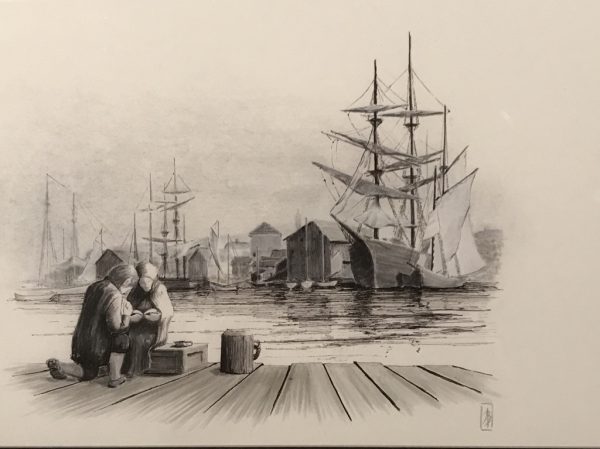
The Wharf at Copenhagen | Artwork by Bill Needs
Historians call the 18th Century the “Age of Reason.” This was a time when many learned to read. New found literacy encouraged the expression of individual opinions. Topics like politics, science, economics, cultural life, philosophy, and religion were allowed to be discussed without fear of punishment. It was an era when the Bush Preacher and the University Professor alike taught concepts of pietism to eager and receptive audiences.
The “Great Awakening” was one expression of the “Age of Reason.” The unbridled discussion had the potential to foster extremism, however. Social groupings emerged; some embraced a traditional approach to religion while others embraced the notion that religion is not logical but ridiculous. Any gray area or compromise between the two extremes was often avoided.
The Moravian Church was not immune to the influence of extremism. Herrnhut was relatively isolated and could cling to its traditions but the new Moravian village of Herrnhaag sat near a crossroads of commerce and intellectual thought. Herrnhaag became a shining model for Moravian theology and practices. Herrnhaag also encountered and succumbed to extreme influences in what is now known as the “Sifting Period” for the Church (“sifting” connoting the biblical reference of separating the wheat from the chaff). After the Sifting Period, the reputation of the Moravian Church would be permanently altered.
Augustus Spangenberg served as Zinzendorf’s “number two man” and acquired unique insights into the events of this era. He will join us for coffee on January 23.
__________________________
About the Author

Photo courtesy of Bill Needs.
Raised in the Moravian Church in Dover Ohio, Bill graduated from Moravian College in 1962. A drop-out of Moravian Theological Seminary, Bill now lives with his wife, Sara in Marietta, Georgia. Bill’s career served disabled individuals and employers in providing realistic vocational choices as a Vocational Rehabilitation Counselor. After retirement in 2004, Bill discovered he had a previously unknown artistic talent for drawing. Now, when Bill and Sara travel, he supplements his photography record with art inspired by the scenes and experiences. For more art, visit Bill’s website at BillNeeds.com. For discussion about art or blog content, email [email protected].
Requests for republishing, click here.
Want to volunteer to write for us? Click here.
